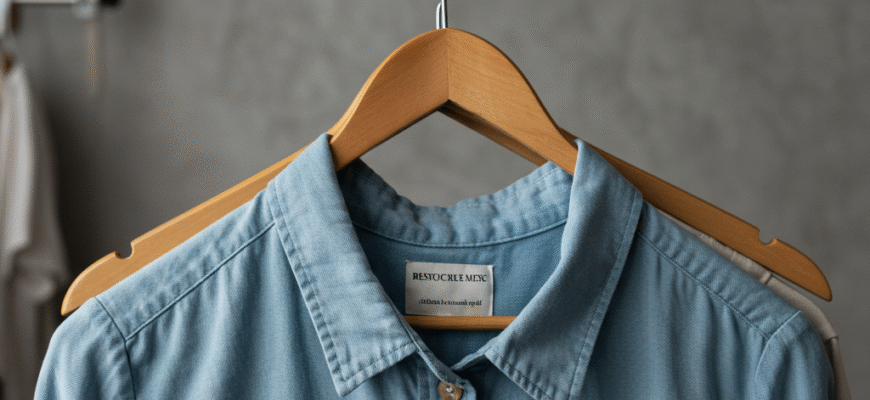Content
The Anti-Wrinkle Power of Hanging
Clothes hangers combat wrinkles through several straightforward principles. Firstly, they utilize gravity. When a garment is placed on a hanger, its own weight gently pulls the fabric downwards. This constant, gentle tension helps to smooth out minor creases and, more importantly, prevents new ones from forming by keeping the fibers relatively straight. Unlike folding, which creates sharp angles, hanging allows the fabric to drape naturally along its intended lines. Secondly, hangers help maintain the garment’s original shape. A well-chosen hanger supports the shoulders or waistband, distributing the garment’s weight evenly. This prevents the stretching and distortion that can occur when clothes are improperly stored or folded awkwardly. Think of a structured blazer: folding it ruins its lines, while hanging it on a sturdy, shaped hanger preserves its silhouette perfectly. Thirdly, hanging promotes air circulation. Clothes packed tightly in drawers or stacked high trap moisture and prevent air from moving freely. This environment can actually help wrinkles set more firmly. Hanged clothes, even in a relatively full closet, have space around them. This airflow helps fabrics stay dry and ‘breathe’, reducing the likelihood of deep-set wrinkles and also preventing musty odors from developing.Bringing Order to the Wardrobe Chaos
Beyond wrinkle prevention, the organizational benefits of hangers are transformative for any closet space. Their primary advantage is leveraging vertical space. Drawers and shelves utilize horizontal surfaces, which quickly become filled and difficult to navigate. Hangers allow you to use the full height of your wardrobe rod, effectively multiplying the usable storage area for many types of clothing. Visibility is another key organizational perk. When clothes are hung, you can typically see a significant portion of each item at a glance. Compare this to a stack of folded t-shirts in a drawer, where only the topmost one is fully visible. Finding a specific shirt, blouse, or pair of trousers becomes a quick scan rather than an archaeological dig through layers of fabric. This improved visibility makes outfit selection faster and less stressful, and also helps you keep track of what you actually own, preventing accidental duplicate purchases. Hangers also facilitate categorization. You can easily group similar items together – all blouses in one section, trousers in another, dresses further along. Within these categories, you can arrange items by color, sleeve length, or occasion. This systematic arrangement makes finding what you need intuitive and simplifies the process of putting clean laundry away. A well-organized, hanger-based system turns a chaotic closet into a functional, curated space.Not All Hangers Are Created Equal: Choosing Wisely
While any hanger is generally better than a pile on the floor, using the right type of hanger for the right garment significantly enhances both wrinkle prevention and organization.Basic Wire Hangers
Often acquired from dry cleaners, these are thin and space-saving but offer minimal support. They can distort the shoulders of heavier garments like sweaters or jackets over time and can leave rust marks if they become damp. Their thin profile can also create sharp creases on delicate fabrics. Best reserved for lightweight shirts or temporary use.Plastic Tubular Hangers
Affordable and widely available, these offer slightly better support than wire hangers due to their wider, rounded shape. They come in various colors, which can aid organization. However, very heavy items might still cause them to bend, and smooth plastic can allow silky or wide-necked garments to slip off easily.Wooden Hangers
These are the stalwarts for heavier items. Their sturdy construction provides excellent support for suits, jackets, coats, and heavy trousers. The wider shoulder area helps maintain the garment’s shape perfectly, preventing shoulder bumps or stretching. They look sophisticated and uniform, instantly upgrading the appearance of a closet. While bulkier and more expensive, their durability and garment care benefits are significant.Velvet or Non-Slip Hangers
These hangers feature a thin profile, similar to wire hangers, maximizing closet space. However, they are coated in a soft, velvety material that provides excellent grip. This makes them ideal for slippery fabrics like silk or rayon, wide-neck tops, tank tops, and delicate straps that tend to slide off plastic or wood. They often include notches for strappy items.Using uniform hangers throughout your closet, such as all slim velvet hangers or all wooden hangers, creates a visually cohesive and less cluttered look. This uniformity not only appears neater but also helps garments hang at the same level, making scanning your wardrobe much easier. It simplifies the process of putting clothes away and finding what you need quickly. Consistency in hangers is a small change with a big organizational impact.









